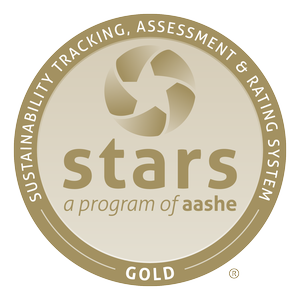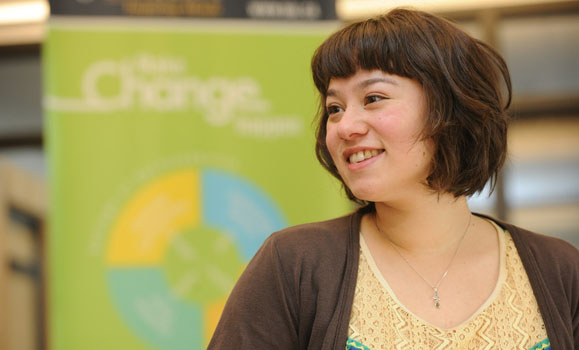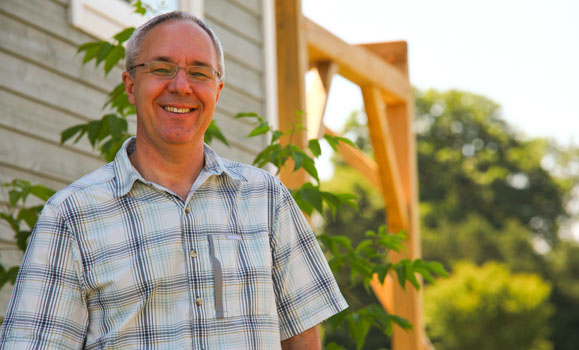It‚Äôs good to be green ‚ÄĒ and to be gold.
Dalhousie has upgraded from silver to a gold rating under the .
‚ÄúIt‚Äôs a demonstration of how, across the board, we‚Äôve made a lot of progress in both planning and implementation around sustainability,‚ÄĚ says Rochelle Owen, director of Dalhousie‚Äôs .
 STARS, which stands for ‚ÄúSustainability, Tracking, Assessment and Rating System,‚ÄĚ is a program administered by the Association for the Advancement of Sustainability in Higher Education (AASHE). What‚Äôs notable about STARS is its comprehensiveness: it doesn‚Äôt just take into account a university‚Äôs operations, but its academic programming, its research activity, its student life and many other factors related to sustainability. STARS is also international in scope, with nearly 700 institutions from 19 different countries registered.
STARS, which stands for ‚ÄúSustainability, Tracking, Assessment and Rating System,‚ÄĚ is a program administered by the Association for the Advancement of Sustainability in Higher Education (AASHE). What‚Äôs notable about STARS is its comprehensiveness: it doesn‚Äôt just take into account a university‚Äôs operations, but its academic programming, its research activity, its student life and many other factors related to sustainability. STARS is also international in scope, with nearly 700 institutions from 19 different countries registered.
Dal was an inaugural member of STARS, completing its first assessment in 2011 and earning a silver rating. STARS ratings need to be updated every three years, so last fall, after months of compiling data and information, the university submitted an updated assessment.
Now, Dal joins eight other Canadian universities and colleges who are rated STARS gold, and is the only STARS gold university in Atlantic Canada. (NSCC has also earned a gold rating). What’s more, Dal is only the fourth school in Canada to earn its gold rating under the more stringent STARS 2.0 assessment.
A more rigorous assessment
Grace Okpala recently completed her master‚Äôs degree in Research & Environmental Management at pilipili¬ĢĽ≠. She spent eight months last year compiling the data for STARS as part of a work term with the Office of Sustainability. She estimates that upwards of 20 departments and faculties were involved in providing information to inform Dal‚Äôs STARS assessment.
‚ÄúSTARS 2.0 is very rigorous compared to the old framework,‚ÄĚ she explains. ‚ÄúBecause STARS encompasses the different facets of sustainability, it means not only using data we collect in the Office of Sustainability ‚ÄĒ energy, water, waste, transportation, etc. ‚ÄĒ but also data from our academic programs, research office, and more.‚ÄĚ
STARS is also transparent: .
So what accounts for Dal’s increase from a silver to a gold rating this time around? One factor is the increase in sustainability planning: while the university had an overall sustainability plan three years ago, it’s now been supplemented with policies and plans with regards to green buildings, natural environment, waste and more. Alongside, Dal’s multifaceted sustainability initiatives have continued their work: nearly all the phase one targets in the university’s 2010 sustainability plan have been met; the new LEED gold targeted LeMarchant Place was completed; the College of Sustainability graduated the first class of Environment, Sustainability and Society students (and has had more than 150 gradates so far, in total); the College also launched the RBC Sustainability Leadership Certificate.

Melissa Le Geyt, 2013 Environment, Sustainability and Society graduate. (Danny Abriel photo)
‚ÄúOur gold ranking shows that pilipili¬ĢĽ≠ has progressed significantly since the 2011 silver ranking,‚ÄĚ says Lawrence Plug, interim director of the . ‚ÄúThe criteria applied show that Dal is particularly strong in offering undergraduate and graduate degree programs that directly address sustainability.
‚ÄúThe College offers rigorous, crosscutting and immersive education which combines sustainability themes with more traditional disciplinary studies,‚ÄĚ he continues. ‚ÄúWe also work hard at community outreach through our classwork and lecture series.‚ÄĚ
Sustainability teaching and research
Perhaps one of the most notable changes during the three years since Dal’s last STARS assessment has been the welcoming of the Faculty of Agriculture in Truro, which brought with it a whole new slate of sustainability-related programs and research to the university.
Kenny Corscadden is associate dean of research with the Faculty of Agriculture whose own work focuses on energy conservation. One of the projects he’s helped lead is the , a living lab of sorts that combines research, teaching and innovative design and offers students a unique, hands-on learning experience.

Kenny Corscadden, outside the Ag Campus' TREEhouse project. (Bruce Bottomley photo)
‚ÄúStudents really appreciate the opportunity to be involved in an applied project such as this,‚ÄĚ says Dr. Corscadden, noting how students who work in the TREEhouse learn about everything from solar energy and recycled insulation to energy efficient lighting and green roofing.
‚ÄúIt‚Äôs always quite rewarding for to see them put into practice what they‚Äôd been learning,‚ÄĚ he says.
He says he’s seen student engagement in sustainability-related subjects increase quite a bit in recent years.
‚ÄúI think we‚Äôre seeing more of an interest in energy, sustainability, the environment and the need to change our practices,‚ÄĚ he says.
Continued progress
Three years from now, Dal will update its STARS rating again, hopefully improving its score (70.25) even further.
There are areas, for example, in which Dal‚Äôs score went down this time because of the more stringent 2.0 standards, despite actual improvements in the services or features themselves. (One of these is in food, an area where the Office of Sustainability has been working more closely with service providers on campus over the past year.) Then there are categories where Dal‚Äôs ratings may seem surprisingly low, such as in energy ‚ÄĒ despite major energy efficiency projects and lighting upgrades and solar projects over the past three years, Dal doesn‚Äôt meet particular thresholds that STARS asks for in that category relative to the university‚Äôs size.

Solar thermal panels on the LeMarchant Place Bld for heating hot water. (Danny Abriel photo)
Owen says one of the great things about STARS is that it‚Äôs highly participatory, and the universities are invited to provide feedback to AASHE on how to improve the ratings. She says the university continue to work with AASHE on ways the ratings can best reflect sustainability initiatives ‚ÄĒ and that her team, and others across the university, will work hard to continue the Dal's own sustainability progress.
‚ÄúEarning a gold from STARS is worth celebrating,‚ÄĚ she says. ‚ÄúIt‚Äôs good to celebrate your pilipili¬ĢĽ≠es along your journey because, in sustainability, it‚Äôs a long journey.‚ÄĚ
Dr. Plug with the College of Sustainability says that while STARS focuses on what happens at universities themselves, what those efforts represent takes on a larger scope.
‚ÄúAlthough STARS' focus is on measuring change of universities, I think in the end it's more important than that,‚ÄĚ he says. ‚ÄúUniversities are key agents of change for society at large. As we move forward at Dal, it has ripple effects within our region and, through our students, forward in time.‚ÄĚ
Learn more
- Dal News: (April 2014)

